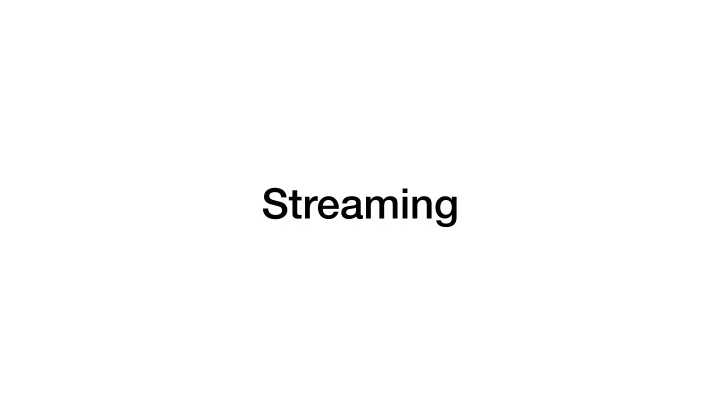

Streaming
Streaming Overview • Our goal: • Build a video sharing site • Same idea as the image sharing site from HW4 • Except: • Videos can be very large • When a user watches a video, we don't want to send the entire file in a single request • Stream the video in small segments
Hosting Video • Viewing an .mp4 file in a browser • Simple since HTML5 • Use the video element • Specify the video file as the source • Each browser implements a video player that will be used < video width="400" controls > < source src="space.mp4" type="video/mp4" > </ video >
Hosting Video • This will download the entire video • What if the video is 1 hour long? • What if the user only watches for 10 seconds? • Think browsing Netflix and watching the intro to 5 di ff erent movies/shows • Don't want to send all 5 entire videos < video width="400" controls > < source src="space.mp4" type="video/mp4" > </ video >
HLS • HTTP Live Streaming • Uses only HTTP[S] • Video is stored in multiple files • Request an index file • .m3u8 • Contains a list of all the files for the video • Host many .ts files containing the video
HLS • The built-in browser player will not play HLS video!
JavaScript Libraries Let's use JavaScript libraries to do cool things without writing code from scratch
JavaScript Libraries < script src="https://momentjs.com/downloads/moment.js" ></ script > Download external libraries using the script tag the same way we downloaded our own code Makes an HTTP request to download the library We can add the script element in the head since we don't need any HTML elements rendered before downloading the library
JavaScript Libraries < script src="https://momentjs.com/downloads/moment.js" ></ script > When the page loads there will be a second request and the library is downloaded The library is simply a JavaScript file that others have written and shared with us for free. We call this open-source since everyone has access to the source code source: https://github.com/moment/moment/
JavaScript Libraries ... <script src="https://momentjs.com/downloads/moment.js"> </script> ... We literally download their code and run it in our browser
JavaScript Libraries Great!.. so what did we just download?
JavaScript Libraries < p id="datetime" ></ p > < script src="script.js" ></ script > var elem = document.getElementById("datetime"); elem.innerHTML = moment().format("YYYY-MM-DD<br/><b>h:mm:ss a</b>") The library defines a function named moment() which returns the current time as an object that contains several methods Here we get the current time and call the format function to choose how it's displayed using date/time placeholders (ex. MM for a 2 digit month)
JavaScript Libraries < p id="datetime" ></ p > < script src="script.js" ></ script > var elem = document.getElementById("datetime"); elem.innerHTML = moment().format("YYYY-MM-DD<br/><b>h:mm:ss a</b>") Displays the time in the <p> element with id "datetime" in the format 2018-10-18 10:23:57 pm
JavaScript Libraries This is ok, but it'd be more useful to show the current time instead of the time our code ran To do this, we'll first wrap our previous code in a function Then we'll call the built-in "setInterval" function with our function as an argument which will call our function at fixed intervals The second argument is a Number representing a time in milliseconds This will call displayTime once per second to give us a live clock function displayTime(){ var elem = document.getElementById("datetime"); elem.innerHTML = moment().format("YYYY-MM-DD<br/><b>h:mm:ss a</b>"); } setInterval(displayTime, 1000);
JavaScript Libraries Reminder: You are learning concepts, not memorizing specific examples The concept is using JavaScript libraries to do cool things without writing code from scratch The moment library was an example of this concept
Recommend
More recommend